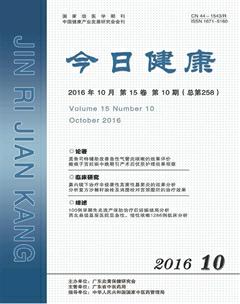不同劑量米非司酮治療子宮肌瘤效果比較觀察
段荔

【摘 要】 目的:觀察治療子宮肌瘤的患者,使用不同劑量米非司酮的效果。方法:選取我院子宮肌瘤患者78例(2015.11月~2016.10月期間),將其簡單隨機化分2組,39例為一組。對照組子宮肌瘤患者——米非司酮使用大劑量,觀察組則使用小劑量,觀察2組的月經狀況,子宮和肌瘤的情況以及激素水平指標的變化。結果:觀察組子宮肌瘤患者的月經狀況(時長6.83±1.37d、總量194.85±30.62 ml)均少于對照組,子宮、肌瘤體積小于對照組,血清激素水平情況優于對照組,故此,2組子宮肌瘤患者之間,對比各項數據有差別,P值小于0.05。結論:對子宮肌瘤患者,臨床上使用小劑量米非司酮進行治療的效果較大劑量更為可觀。
【關鍵詞】 米非司酮 子宮肌瘤 月經
To observe the effect of different doses of mifepristone on uterine leiomyoma
[Abstract] Objective: To observe the effect of different doses of mifepristone on patients with uterine leiomyoma. Methods: In our hospital from November 2015 to October 2016, 78 cases of uterine fibroids were divided into two groups of simple randomization, 39 cases as a group. In the control group, the patients of uterine leiomyoma were treated with mifepristone at a high dose. The observation group was treated with low dose, and the menstrual status, the uterus and fibroids and the changes of hormone level were observed. Results: In the observation group, the menstrual status (length 6.83±1.37 days, total 194.85±30.62 ml) of uterine leiomyoma patients was less than that of the control group, and the volume of uterus and fibroids was smaller than that of the control group, the serum hormone level was better than the control group. Group of patients with uterine fibroids, the contrast data are different, P value of less than 0.05. Conclusion: In patients with uterine leiomyoma, the clinical effect of using small doses of mifepristone treatment is more impressive dose.
[Key words] Mifepristone; Uterine fibroids; Menstruation
臨床數據顯示,子宮肌瘤疾病在育齡期女性當中的發病概率高達25.00% [1],而臨床上常用以治療此疾病的藥物之一即為米非司酮。本文研究旨在針對子宮肌瘤疾病患者進行分組研究,采取不同劑量的米非司酮治療,對比其效果,具體見下。
1 基線資料、方法
1.1 基線資料
選取在我院治療子宮肌瘤的患者(共收集78例)作為研究對象,所選時間屬于2015年11月到2016年10月,將其簡單隨機化分組,分為觀察組、對照組這2組,39例為一組。
2組選取的子宮肌瘤患者均不存在米非司酮治療的禁忌情況,三個月內未使用激素進行治療,不會對本次研究造成影響,所有的子宮肌瘤患者均屬于自愿進行研究和治療,簽署知情同意書。
觀察組——患者年齡范圍在22歲到53歲之間,年齡平均值是(35.48±3.53)歲,患者的病程時長是1年~5年之間,時長平均(3.52±1.62)年。其中患者的肌瘤情況包括:肌壁間肌瘤患者--11例,漿膜下肌瘤共計--13例,粘膜下肌瘤有--15例。
對照組——患者年齡范圍在23歲到52歲之間,年齡平均值是(35.68±3.32)歲,患者的病程時長是1年~6年之間,時長平均(3.83±1.39)年。患者的上述情況例數分別是12、10、17例。
對2組子宮肌瘤患者的基線資料對比后,得出結果差別較小,故2組可以實施科學的對比。
1.2 方法
對照組子宮肌瘤患者——大劑量米非司酮治療,在患者月經第一天到第三天的時間,均口服50.00mg/d劑量的米非司酮(晚餐后進行),之后禁食1小時,共計治療3個月[2]。
觀察組子宮肌瘤患者——米非司酮選取小劑量用藥,用藥方式同上,劑量為12.50mg/d [3]。
1.3 觀察指標
觀察2組子宮肌瘤患者的月經狀況(時長和總量),子宮和肌瘤的各項體積值,記錄2組的血清激素水平,包括FSH——促卵泡生成素水平,LH——黃體生成素水平,E2——雌激素水平,P——孕激素水平,PRL——催乳素水平等。

